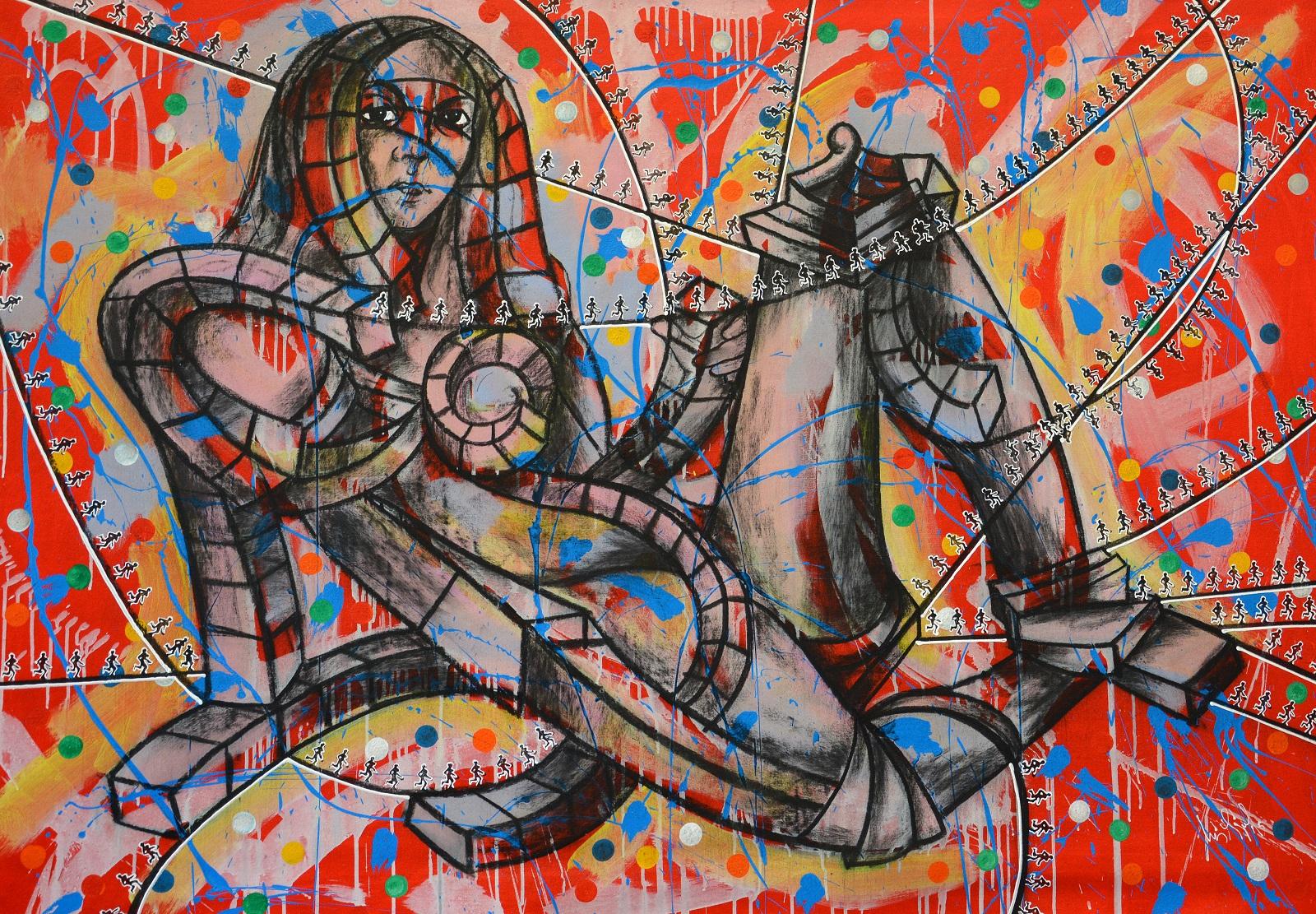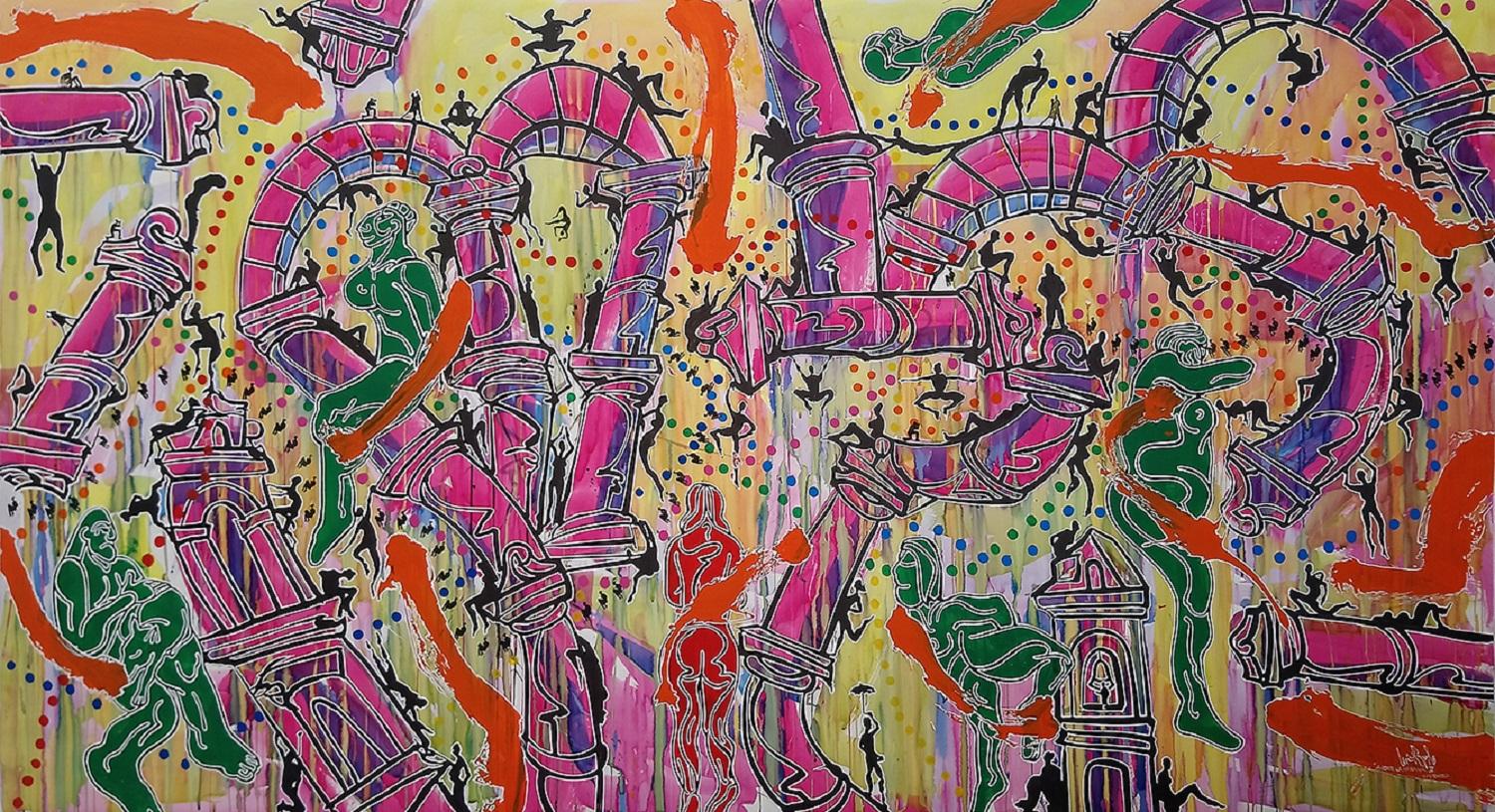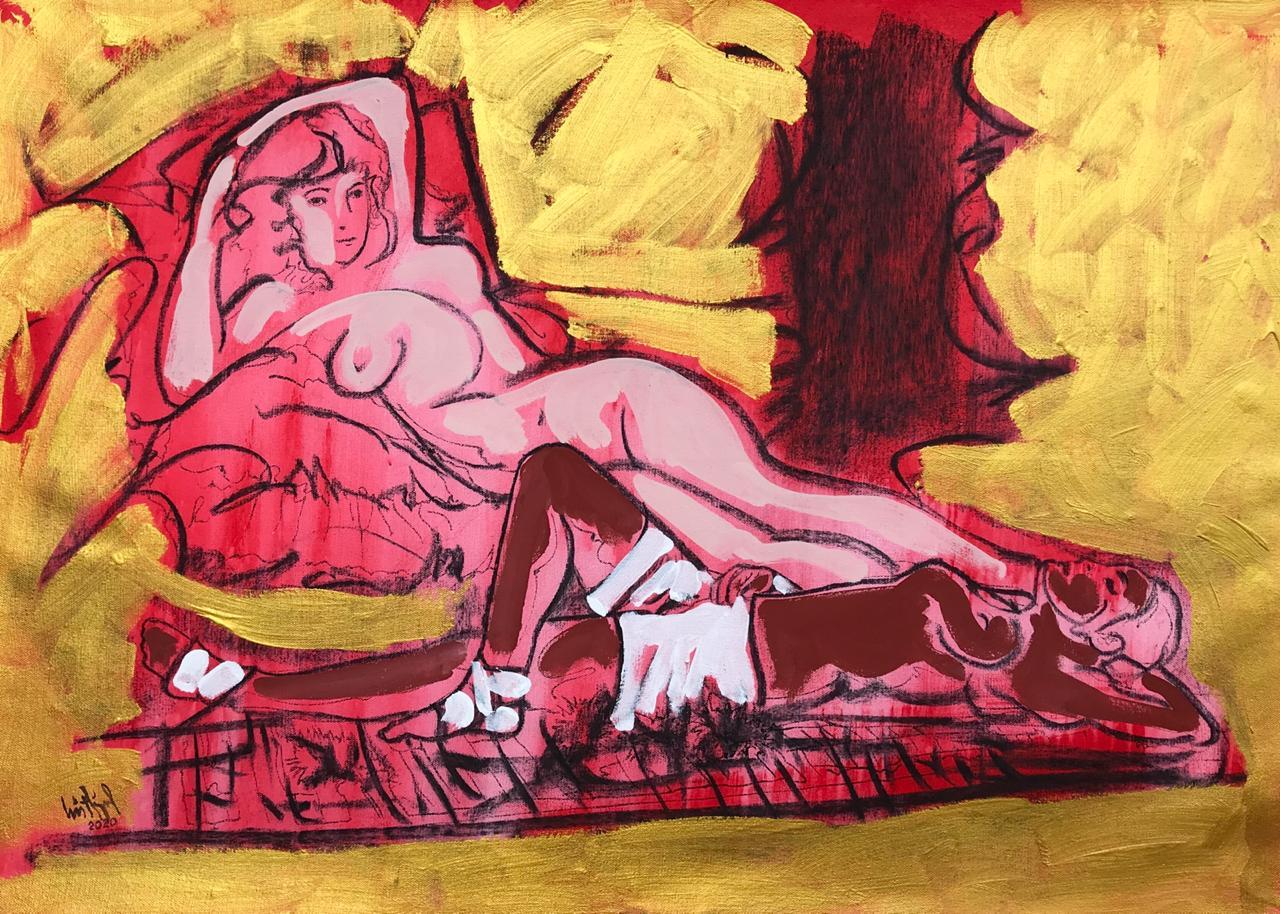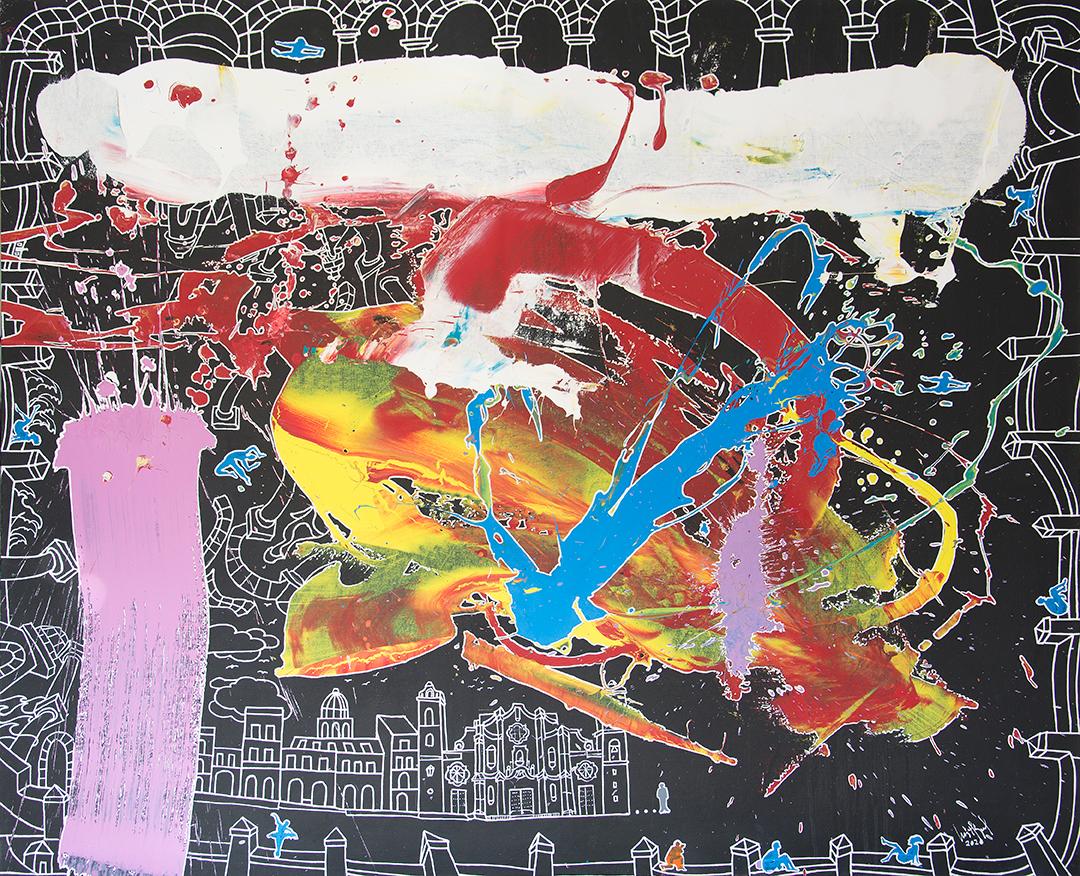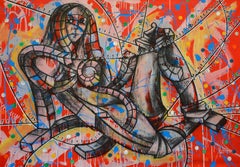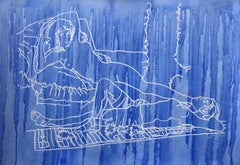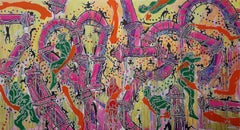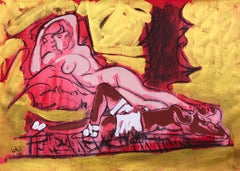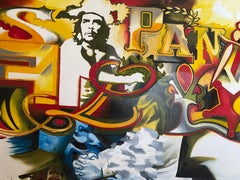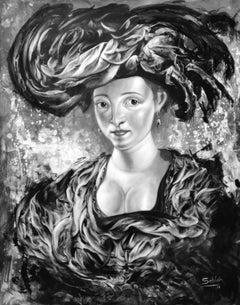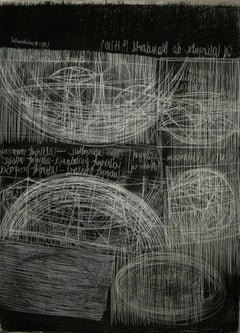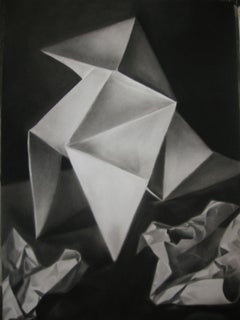Items Similar to Luis Miguel Valdes large charcoal on canvas 10x30 feet (see making-of video )
Video Loading
Want more images or videos?
Request additional images or videos from the seller
1 of 16
Luis Miguel Valdes Luis Miguel Valdes large charcoal on canvas 10x30 feet (see making-of video )2016
2016
$130,000
£97,725.67
€113,295.03
CA$181,500.23
A$203,289.86
CHF 105,778.47
MX$2,468,941.06
NOK 1,341,002.23
SEK 1,265,335.50
DKK 845,342.24
Shipping
Retrieving quote...The 1stDibs Promise:
Authenticity Guarantee,
Money-Back Guarantee,
24-Hour Cancellation
About the Item
(Added new images and video of the creation process, enjoy it)
Author: Luis Miguel Valdes (Cuban, 1949)
Title: Symphony La Siempre Habana
Size: 305x1015 cm. (10x30 ft.)
Medium: Charcoal on canvas
Date: Aug to Oct, 2016
Luis Miguel Valdés, Biography
Luis Miguel Valdés, a renowned Cuban painter and printmaker, was born in 1949 in Pinar del Río, Cuba. From an early age, he showed a great interest in artistic creation, influenced by the rich cultural environment of his homeland.
Studies ans education:
Valdés completed his formal education at the National Art School (ENA) and the Higher Institute of Art (ISA) in Havana. During his studies, he was guided by mentors such as Servando Cabrera Moreno and Espinoza Dueñas, who played a crucial role in his artistic development. He was also influenced by art masters like Francis Bacon, Pablo Picasso, and Valerio Adami. Between 1969 and 1991, Valdés founded and directed the ISA's Department of Printmaking, where he supervised 58 senior projects, leaving a significant mark on Cuban art education.
Valdés later received a scholarship at S.W. Hayter’s studio in Paris, enriching his technique and expanding his artistic vision. In 1983, his recognition and prestige grew as he became Vice President of the International Art Association (IAA) for Latin America and the Caribbean. In 2000, he founded La Siempre Habana, an institution dedicated to limited edition prints, establishing himself as a reference in the field of printmaking.
Early Career
Valdés began his artistic career with a series of works exhibited in various European countries. This early stage was crucial for the development of his style, which combines realism and symbolism to address everyday life and social challenges. His early works explored cultural identity through the human figure, portraiture, architecture, and history, creating a unique iconography that has become his hallmark.
Development of Style
Valdés' distinctive style is characterized by the fusion of realism and symbolism, addressing recurring themes such as cultural identity and social challenges. His constant search and artistic exploration have allowed him to develop a wide variety of forms and treatments in his work, without worrying about maintaining a strict thematic or formal unity. Valdés believes that the act of creation itself is the content and the main reason for the result, allowing him notable expressive freedom.
Although Valdés masters various techniques, he has particularly excelled in printmaking, painting, and drawing. His technical skill and innovative approach have allowed him to create works that are not only visually impactful but also invite deep reflection on culture and society.
Major Works and Projects
Among Luis Miguel Valdés' most important works is the mural for the Salon de Mayo in 1968, created alongside iconic figures such as Wifredo Lam and Valerio Adami. Also notable is his award-winning print of Havana Cathedral and the impressive 10-meter mural drawing on canvas titled "Symphony La Siempre Habana." Valdés pioneered the first digital art exhibition in Cuba during the 1980s and introduced digital art to television post-production. He also founded the Taller La Siempre Habana, an international reference in contemporary graphic art editions.
Awards and Recognitions
Throughout his career, Valdés has received numerous awards and honors. In 1966, at the age of 17, he won the lithography prize at the International Figurative Art Exhibition in Milan, Italy. In 1968, he received the collective award at the Salon de Mai in Paris, France. Between 1973 and 1990, he won several awards and mentions at the UNEAC National Salon in Havana. In 1997, he received the third prize at the Steel Sculpture Symposium in Tultepec, Mexico, and in 2018 was a finalist at the Guanlan Print Biennial in China.
Exhibitions and Collections
Valdés has participated in numerous international exhibitions. Some of the most notable include the National Museum of Fine Arts in Havana in 1981, the Westing Regina Gallery in Cancun in 1994, the La Siempre Habana Gallery in Mexico City in 2006, the Marriott Reforma in Mexico City in 2010, and the Moisés Valdés Gallery in Miami in 2015. His works are part of collections in museums such as the National Museum of Fine Arts in Havana, the China Printmaking Museum in Shanghai, the Marriott Reforma in Mexico City, the University Museum of Contemporary Art (MUAC) at UNAM in Mexico City, and the Museum of Contemporary Art North Miami (MoCA) in Miami, Florida.
Historical and Cultural Context
The historical and cultural context of the era in which Valdés has lived has profoundly influenced his work. His relationship with contemporary art movements is reflected in his work, which addresses pertinent and resonant themes in today's society. Through his art, Valdés has commented on social challenges, cultural identity, and history, becoming a visual narrator of his time.
Influence and Legacy
Valdés ventured into digital art in the 1980s, being a pioneer in Cuba and one of the few worldwide. His distinctive style and focus on cultural and social themes have influenced other artists and movements, leaving a lasting impact on contemporary culture and art. His contribution to the introduction of new technologies and techniques in art has been especially significant.
- Creator:Luis Miguel Valdes (1949, Cuban)
- Creation Year:2016
- Dimensions:Height: 118 in (299.72 cm)Width: 393 in (998.22 cm)
- Medium:
- Movement & Style:
- Period:
- Condition:
- Gallery Location:Miami, FL
- Reference Number:1stDibs: LU185429952752
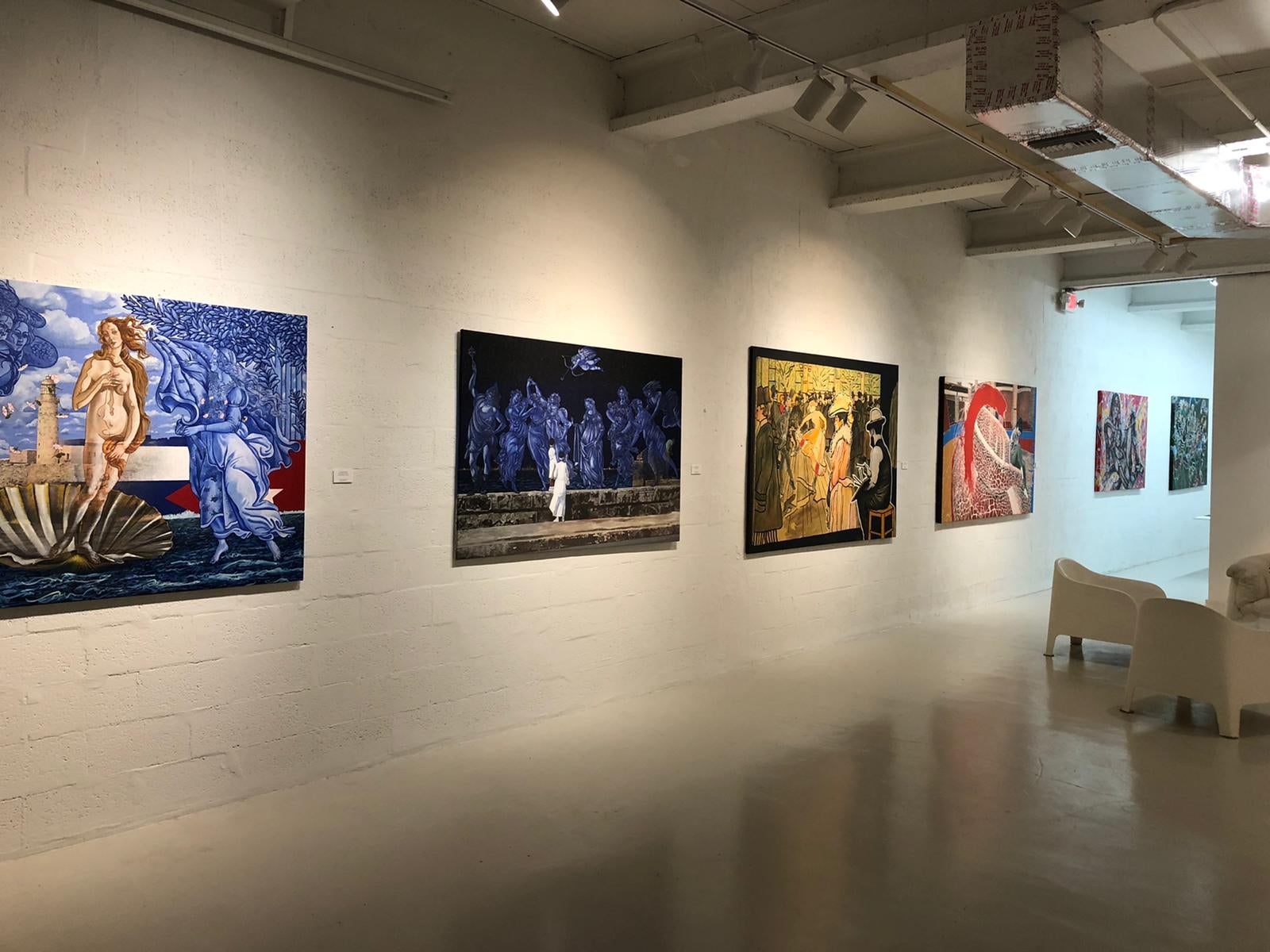
About the Seller
5.0
Vetted Professional Seller
Every seller passes strict standards for authenticity and reliability
Established in 2000
1stDibs seller since 2022
102 sales on 1stDibs
- ShippingRetrieving quote...Shipping from: Miami, FL
- Return Policy
Authenticity Guarantee
In the unlikely event there’s an issue with an item’s authenticity, contact us within 1 year for a full refund. DetailsMoney-Back Guarantee
If your item is not as described, is damaged in transit, or does not arrive, contact us within 7 days for a full refund. Details24-Hour Cancellation
You have a 24-hour grace period in which to reconsider your purchase, with no questions asked.Vetted Professional Sellers
Our world-class sellers must adhere to strict standards for service and quality, maintaining the integrity of our listings.Price-Match Guarantee
If you find that a seller listed the same item for a lower price elsewhere, we’ll match it.Trusted Global Delivery
Our best-in-class carrier network provides specialized shipping options worldwide, including custom delivery.More From This Seller
View AllPainting oil, acrylic and charcoal on canvas, "Andar la Habanera" 2015 48x72in
By Luis Miguel Valdes
Located in Miami, FL
Luis Miguel Valdes (Cuban, 1949)
"Andar la Habanera", 2015
Mixed media on Canvas (oil, acrylic, and charcoal)
48 × 72 in (121.9 × 182.9 cm)
Signed and framed
Luis Miguel Valdés, Bio...
Category
2010s Contemporary Figurative Paintings
Materials
Acrylic, Oil, Canvas
Luis Miguel Valdés ¨Maja y Fama IV¨, 2020, Acrylic, 23.6x35.4 in
By Luis Miguel Valdes
Located in Miami, FL
"Luis Miguel Valdes (Cuba, 1949)
'Maja y Fama IV', 2020
acrylic on canvas
23.7 x 35.5 in. (60 x 90 cm.)
ID: VAL- "
Category
2010s Contemporary Paintings
Materials
Canvas, Oil, Acrylic
Luis Miguel Valdés ¨Andar La Habana II¨, 2018, Acrylic, 59.1x106.3 in
By Luis Miguel Valdes
Located in Miami, FL
Luis Miguel Valdes (Cuba, 1949)
'Andar La Habana II', 2018
acrylic and oil on canvas
59.1 x 106.3 in. (150 x 270 cm.)
ID: VAL
Category
2010s Contemporary Figurative Paintings
Materials
Canvas, Oil, Acrylic, Paint
Luis Miguel Valdés ¨Maja y Fama III¨, 2020, Acrylic, 23.6x35.4 in
By Luis Miguel Valdes
Located in Miami, FL
"Luis Miguel Valdes (Cuba, 1949)
'Maja y Fama III', 2020
acrylic on canvas
23.7 x 35.5 in. (60 x 90 cm.)
ID: VAL- "
Category
2010s Contemporary Paintings
Materials
Canvas, Oil, Acrylic
"4 + 14" 2023 acrylic painting on canvas 63x138 in figurative abstract art drip
By Luis Miguel Valdes
Located in Miami, FL
Luis Miguel Valdes (Cuba, 1949)
"4 + 14", 2024
acrylic on canvas
63 x 138 in.
Category
2010s Contemporary Figurative Paintings
Materials
Canvas, Paint, Oil, Acrylic
Luis Miguel Valdés ¨Andar La Habana III¨, 2020, Acrylic, 45.3x55.1 in
By Luis Miguel Valdes
Located in Miami, FL
"Luis Miguel Valdes (Cuba, 1949)
'Andar La Habana III', 2020
acrylic on canvas
45.3 x 55.2 in. (115 x 140 cm.)
ID: VAL- "
Category
2010s Contemporary Paintings
Materials
Canvas, Oil, Acrylic
You May Also Like
"Untitled" Acrylic painting 48" x 60" inch
Located in Culver City, CA
"Untitled" Acrylic painting 48" x 60" inch
Artist: Unknown
Originally bought in NYC from pop up gallery event.
The painting shows minor signs of w...
Category
21st Century and Contemporary Street Art Figurative Paintings
Materials
Canvas, Acrylic
$2,475 Sale Price
55% Off
Cuban Contemporary Art by Carlos Sablon Perez - From Serie "Blanc & Noir"
By Carlos Antonio Sablon Perez
Located in Paris, IDF
Acrylic on canvas
Carlos Sablòn Perez is a Cuban artist born in 1981 who lives & works in Châlons-en-Champagne, France. His talent is quickly recognized in the four corners of the C...
Category
2010s Contemporary Figurative Paintings
Materials
Acrylic, Paper
Drawing 14, Series Drawing - Large Format, Charcoal On Paper Panting
By Krzysztof Gliszczyński
Located in Salzburg, AT
The artwork is unframed and will be shipped rolled in a tube
Krzysztof Gliszczyński is Professor for painting on Academy of fine arts Gdansk.
Krzysztof Gliszczyński born in Miastko in 1962. Graduated from the Gdańsk Academy of Fine Arts in 1987 in the studio of Prof. Kazimierz Ostrowski. Between 1995 and 2002 founder and co-manager of Koło Gallery in Gdańsk. lnitiator of the Kazimierz Ostrowski Award, con-ferred by the Union of Polish Artists and Designers (ZPAP), Gdańsk Chapter. Dean of the Painting Faculty of the Gdańsk Academy of Fine Arts in the years 2008-2012. Vice Rector for Development and Cooperation of the Gdańsk Academy of Fine Arts in the years 2012-2016. Obtained a professorship in 2011. Currently head of the Third Painting Studio of the Painting Faculty of the Gdańsk Academy of Fine Arts. He has taken part in a few dozen exhibitions in Poland and abroad. He has received countless prizes and awards for his artistic work. He is active in the field of painting, drawing, objects, and video.
Artist Statement
In the 1990s I started collecting flakes of paint – leftovers from my work. I would put fresh ones in wooden formworks, dried ones in glass containers. They constituted layers of investigations into the field of painting, enclosed in dated and numbered cuboids measuring 47 × 10.5 × 10.5 cm. I called those objects Urns. In 2016, I displayed them at an exhibition, moulding a single object out of all the Urns. The Urns inspired me to redefine the status of my work as a painter. In order to do it, I performed a daunting task of placing the layers of paint not in an urn, but on a canvas, pressing each fresh bit of paint with my thumb. In the cycle of paintings Autoportret a’retour, the matter was transferred from painting to painting, expanding the area of each consecutive one. Together, the bits, the residua of paint, kept alive the memory of the previous works. It was a stage of the atomization of the painting matter and its alienation from the traditional concepts and aesthetic relations. Thus, the cycle of synergic paintings was created, as I called them, guided by the feeling evoked in me by the mutually intensifying flakes of paint. The final aesthetic result of the refining of the digested matter was a consequence of the automatism of the process of layering, thumb-pressing, and scraping off again. Just like in an archaeological excavation, attempts are made to unite and retrieve that which has been lost. This avant-garde concept consists in transferring into the area of painting of matter, virtually degraded and not belonging to the realm of art. And yet the matter re-enters it, acquiring a new meaning. The matter I created, building up like lava, became my new technique. I called it perpetuum pictura – self-perpetuated painting. Alchemical concepts allowed me to identify the process inherent in the emerging matter, to give it direction and meaning. In a way, I created matter which was introducing me into the pre-symbolic world – a world before form, unnamed. From this painterly magma, ideas sprung up, old theories of colour and the convoluted problem of squaring the circle manifested themselves again. Just like Harriot’s crystal refracted light in 1605, I tried to break up colour in the painting Iosis. Paintings were becoming symptoms, like in the work Pulp fiction, which at that time was a gesture of total fragmentation of matter and of transcending its boundaries, my dialogue with the works of Jackson Pollock and the freedom brought by his art. The painting Geometrica de physiologiam pictura contains a diagram in which I enter four colours that constitute an introduction to protopsychology, alchemical transmutation, and the ancient theory of colour. It this work I managed to present the identification of the essence of human physiology with art. But the essential aspect of my considerations in my most recent paintings is the analysis of abstraction, the study of its significance for the contemporary language of art and the search for the possibilities of creating a new message. For me, abstraction is not an end in itself, catering to the largely predicable expectations of the viewers. To study the boundary between visibility and invisibility, like in the work Unsichtbar, is to ask about the status of the possibilities of the language of abstraction. The moment of fluidity which I am able to attain results from the matter – matter...
Category
Early 2000s Conceptual Figurative Drawings and Watercolors
Materials
Paper, Charcoal
Pajarita, Drawing, Charcoal on Paper
By Anyck Alvarez Kerloch
Located in Yardley, PA
Charcoal on archival quality Ingres paper. I love working with charcoal. It creates wonderful velvety blacks. I set this composition one day when making some origami figures for my s...
Category
2010s Contemporary Drawings and Watercolor Paintings
Materials
Charcoal
Pajarita, Drawing, Charcoal on Paper
By Anyck Alvarez Kerloch
Located in Yardley, PA
Charcoal on archival quality Ingres paper. I love working with charcoal. It creates wonderful velvety blacks. I set this composition one day when making some origami figures for my s...
Category
2010s Contemporary Drawings and Watercolor Paintings
Materials
Charcoal
Minimalist Figurative Drawing by Cuban artist Juan Carlos Vazquez Lima
Located in Brooklyn, NY
Minimalist Figurative Drawing by Cuban artist Juan Carlos Vazquez Lima.
Original Unique Piece.
Juan Carlos was born in Havana Cuba June 30th 1986. He Studied at Eduardo Garcia Delg...
Category
2010s Modern Figurative Paintings
Materials
Acrylic, Ballpoint Pen
Juan Carlos Vazquez LimaMinimalist Figurative Drawing by Cuban artist Juan Carlos Vazquez Lima, 2022
$1,120 Sale Price
20% Off
Free Shipping
